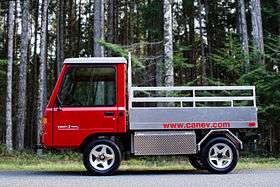Truck
A truck or lorry is a motor vehicle designed to transport cargo. Trucks vary greatly in size, power, and configuration; smaller varieties may be mechanically similar to some automobiles. Commercial trucks can be very large and powerful and may be configured to be mounted with specialized equipment, such as in the case of refuse trucks, fire trucks, concrete mixers, and suction excavators. In American English, a commercial vehicle without a trailer or other articulation is formally a "straight truck" while one designed specifically to pull a trailer is not a truck but a "tractor".[1]
.jpg)
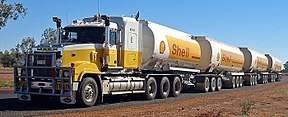

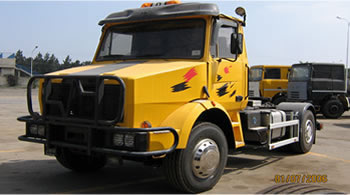
Modern trucks are largely powered by diesel engines, although small to medium size trucks with gasoline engines exist in the US, Canada, and Mexico. In the European Union, vehicles with a gross combination mass of up to 3.5 t (7,700 lb) are known as light commercial vehicles, and those over as large goods vehicles.
History
Steam wagons
Trucks and cars have a common ancestor: the steam-powered fardier Nicolas-Joseph Cugnot built in 1769. However, steam wagons were not common until the mid-19th century. The roads of the time, built for horse and carriages, limited these vehicles to very short hauls, usually from a factory to the nearest railway station. The first semi-trailer appeared in 1881, towed by a steam tractor manufactured by De Dion-Bouton. Steam-powered wagons were sold in France and the United States until the eve of World War I, and 1935 in the United Kingdom, when a change in road tax rules made them uneconomic against the new diesel lorries.
Internal combustion
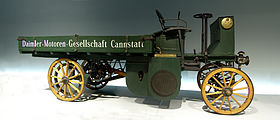
In 1895 Karl Benz designed and built the first truck in history using the internal combustion engine. Later that year some of Benz's trucks were modified to become the first bus by the Netphener, the first motorbus company in history. A year later, in 1896, another internal combustion engine truck was built by Gottlieb Daimler.[2] Other companies, such as Peugeot, Renault and Büssing, also built their own versions. The first truck in the United States was built by Autocar in 1899 and was available with optional 5 or 8 horsepower motors.[3]
Trucks of the era mostly used two-cylinder engines and had a carrying capacity of 3,300 to 4,400 lb (1.5 to 2 t). In 1904, 700 heavy trucks were built in the United States, 1000 in 1907, 6000 in 1910, and 25000 in 1914.
After World War I, several advances were made: pneumatic tires replaced the previously common full rubber versions. electric starters, power brakes, 4, 6, and 8 cylinder engines, closed cabs, and electric lighting followed. The first modern semi-trailer trucks also appeared. Touring car builders such as Ford and Renault entered the heavy truck market.
Diesel engines
Although it had been invented in 1897, the diesel engine did not appear in production trucks until Benz introduced it in 1923.[4] The diesel engine was not common in trucks in Europe until the 1930s. In the United States, Autocar introduced diesel engines for heavy applications in the mid-1930s. Demand was high enough that Autocar launched the "DC" model (diesel conventional) in 1939. However, it took much longer for diesel engines to be broadly accepted in the US: gasoline engines were still in use on heavy trucks in the 1970s.[5][6]
Etymology
Truck is used in American English, and is common in Canada, Australia, New Zealand, Pakistan and South Africa, while lorry is the equivalent in British English, and is the usual term in countries like Ireland, Malaysia, Singapore and India.
The first known usage of "truck" was in 1611 when it referred to the small strong wheels on ships' cannon carriages. In its extended usage, it came to refer to carts for carrying heavy loads, a meaning known since 1771. Its expanded application to "motor-powered load carrier" has been in usage since 1930, shortened from "motor truck", which dates back to 1901.[7][8]
"Lorry" has a more uncertain origin, but probably has its roots in the rail transport industry, where the word is known to have been used in 1838 to refer to a type of truck (a goods wagon as in British usage, not a bogie as in the American), specifically a large flat wagon. It might derive from the verb lurry (to carry or drag along, or to lug) which was in use as early as 1664, but that association is not definitive.[9] The expanded meaning of lorry, "self-propelled vehicle for carrying goods", has been in usage since 1911.[10][11]
International variance
In the United States, Canada, and the Philippines "truck" is usually reserved for commercial vehicles larger than normal cars and includes pickups and other vehicles having an open load bed. In Australia, New Zealand and South Africa, the word "truck" is mostly reserved for larger vehicles; in Australia and New Zealand, a pickup truck is usually called a ute (short for "utility"),[12] while in South Africa it is called a bakkie (Afrikaans: "small open container"). In the United Kingdom, India, Malaysia, Singapore, Ireland, and Hong Kong lorry is used instead of truck, but only for the medium and heavy types, while truck is used almost exclusively to refer to pickups.
Types by size
Ultra light
Often produced as variations of golf cars, with internal combustion or battery electric drive, these are used typically for off-highway use on estates, golf courses, and parks. While not suitable for highway use some variations may be licensed as slow speed vehicles for operation on streets, generally as a body variation of a neighborhood electric vehicle. A few manufactures produce specialized chassis for this type of vehicle, while Zap Motors markets a version of their Xebra electric tricycle (licensable in the U.S. as a motorcycle).
Very light

Popular in Europe and Asia, many mini-trucks are factory redesigns of light automobiles, usually with monocoque bodies. Specialized designs with substantial frames such as the Italian Piaggio shown here are based upon Japanese designs (in this case by Daihatsu) and are popular for use in "old town" sections of European cities that often have very narrow alleyways.
Regardless of the name, these small trucks serve a wide range of uses. In Japan, they are regulated under the Kei car laws, which allow vehicle owners a break in taxes for buying a smaller and less-powerful vehicle (currently, the engine is limited to 660 cc displacement). These vehicles are used as on-road utility vehicles in Japan. These Japanese-made mini trucks that were manufactured for on-road use are competing with off-road ATVs in the United States, and import regulations require that these mini trucks have a 25 mph (40 km/h) speed governor as they are classified as low-speed vehicles.[13] These vehicles have found uses in construction, large campuses (government, university, and industrial), agriculture, cattle ranches, amusement parks, and replacements for golf carts.[14]
Major mini truck manufacturers and their brands:
Light

Light trucks are car-sized (in the US, no more than 13,900 lb (6.3 t)) and are used by individuals and businesses alike. In the EU they may not weigh more than 3.5 t (7,700 lb) and are allowed to be driven with a driving licence for cars. Pickup trucks, called utes in Australia and New Zealand, are common in North America and some regions of Latin America, Asia, and Africa, but not so in Europe, where this size of commercial vehicle is most often made as vans.
Medium
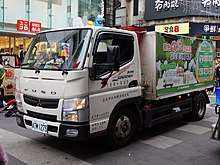
Medium trucks are larger than light but smaller than heavy trucks. In the US, they are defined as weighing between 13,000 and 33,000 lb (5,900 and 15,000 kg). For the UK and the EU the weight is between 3.5 to 7.5 t (3.4 to 7.4 long tons; 3.9 to 8.3 short tons). Local delivery and public service (dump trucks, garbage trucks and fire-fighting trucks) are normally around this size.
Heavy
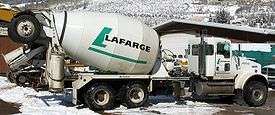
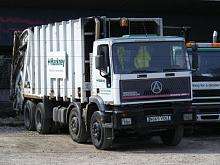
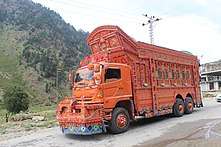

Heavy trucks are the largest on-road trucks, Class 8. These include vocational applications such as heavy dump trucks, concrete pump trucks, and refuse hauling, as well as ubiquitous long-haul 4x2 and 6×4 tractor units.[15]
Road damage and wear increase very rapidly with the axle weight. The number of steering axles and the suspension type also influence the amount of the road wear. In many countries with good roads a six-axle truck may have a maximum weight of 44 t (97,000 lb) or more.
Off-road
Off-road trucks include standard, extra heavy-duty highway-legal trucks, typically outfitted with off-road features such as a front driving axle and special tires for applications such as logging and construction, and purpose-built off-road vehicles unconstrained by weight limits, such as the Liebherr T 282B mining truck.
Maximum sizes by country
Australia has complex regulations over weight and length, including axle spacing, type of axle/axle group, rear overhang, kingpin to rear of trailer, drawbar length, ground clearance, as well as height and width laws. These limits are some of the highest in the world, a B-double can weigh 62.5 t (61.5 long tons; 68.9 short tons) and be 25 m (82 ft) long, and road trains used in the outback can weigh 172 t (169.3 long tons; 189.6 short tons) and be 53.5 m (176 ft) long.[17][18]
The European Union also has complex regulations. The number and spacing of axles, steering, single or dual tires, and suspension type all affect maximum weights. Length of a truck, of a trailer, from axle to hitch point, kingpin to the rear of the trailer, and turning radius are all regulated. In additions, there are special rules for carrying containers, and countries can set their own rules for local traffic.[19]
The United States Federal Bridge Law deals with the relation between the gross weight of the truck, the number of axles, the weight on and the spacing between the axles that the truck can have on the Interstate highway system.[20] Each State determines the maximum permissible vehicle, combination, and axle weight on state and local roads.
| Country | Maximum with three axles | With one trailer | Maximum combination |
|---|---|---|---|
| Australia[17][18] | 23 t (22.6 long tons; 25.4 short tons) | 12 m (39 ft) | 172 t (169.3 long tons; 189.6 short tons) 53.5 m (176 ft) |
| China[21] | 25 t (24.6 long tons; 27.6 short tons) 12 m (39 ft) | 49 t (48.2 long tons; 54.0 short tons) 16.5 m (54 ft) | 55 t (54.1 long tons; 60.6 short tons) 18.75 m (62 ft) |
| EU[19] | 26 t (25.6 long tons; 28.7 short tons) 12 m (39 ft) | 16.5 m (54 ft) | 44 t (43.3 long tons; 48.5 short tons) 18.75 m (62 ft) |
| Finland[22] | 28 t (27.6 long tons; 30.9 short tons) 13 m (43 ft) | 76 t (74.8 long tons; 83.8 short tons) 34.5 m (113 ft 2 in) | 76 t (74.8 long tons; 83.8 short tons) 34.5 m (113 ft) |
| Ireland[23] | 26 t (25.6 long tons; 28.7 short tons) 12 m (39 ft) | 30 t (29.5 long tons; 33.1 short tons) 16.5 m (54 ft 2 in) | 44 t (43.3 long tons; 48.5 short tons) 22 m (72 ft) |
| Sweden[24] | 26 t (25.6 long tons; 28.7 short tons) 24 m (79 ft) | 60 t (59.1 long tons; 66.1 short tons) 24 m (78 ft 9 in) | 60 t (59.1 long tons; 66.1 short tons) 25.25 m (82.8 ft) |
| UK[25][26][27] | 26 t (25.6 long tons; 28.7 short tons) 12 m (39 ft) | 150 t (147.6 long tons; 165.3 short tons) 16 m (52 ft) | 150 t (147.6 long tons; 165.3 short tons) 18.75 m (62 ft) |
| USA[28][29] (Interstate) | 54,000 lb (24,000 kg) 45 ft (13.7 m) | 80,000 lb (36,000 kg) none | 80,000 lb (36,000 kg) none |
Uniquely, the State of Michigan has a gross vehicle weight limit of 164,000 lb (74,000 kg), which is twice the U.S. federal limit.[30][31][32] A measure to change the law was defeated in the Michigan Senate in 2019.[33][34][35][36][37]
Design
Almost all trucks share a common construction: they are made of a chassis, a cab, an area for placing cargo or equipment, axles, suspension and roadwheels, an engine and a drivetrain. Pneumatic, hydraulic, water, and electrical systems may also be present. Many also tow one or more trailers or semi-trailers.
Cab
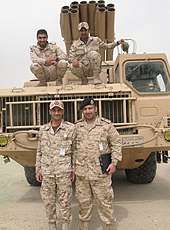
The "cab" is an enclosed space where the driver is seated. A "sleeper" is a compartment attached to or integral with the cab where the driver can rest while not driving, sometimes seen in semi-trailer trucks.
There are several possible cab configurations:
- "Cab over engine" (COE) or "flat nose"; where the driver is seated above the front axle and the engine. This design is almost ubiquitous in Europe, where overall truck lengths are strictly regulated, but widely used in the rest of the world as well. They were common in North American heavy-duty trucks but lost prominence when the permitted length was extended in the early 1980s. Nevertheless, this design is still popular in North America among medium- and light-duty trucks. To reach the engine, the whole cab tilts forward, earning this design the name of "tilt-cab". This type of cab is especially suited to the delivery conditions in Europe where many roads follow the layout of much more ancient paths and trackways which require the additional turning capability given by the short wheelbase of the cab over engine type.[38] The COE design was invented by Viktor Schreckengost.[39]
- "Conventional" cabs are the most common in North America, Australia, and China, and are known in the UK as "American cabs" and in the Netherlands as "torpedo cabs". The driver is seated behind the engine, as in most passenger cars or pickup trucks. Many new cabs are very streamlined, with a sloped hood (bonnet) and other features to lower drag.
- "Cab beside engine" designs also exist, but are rather rare and are used on terminal tractors at shipping yards or other specialist uses that require the vehicle to carry long loads such as pipes, metal rods, flat iron, and other construction materials. This type is often custom made from a regular cab-over truck that gets the upper half of its cab removed on the passenger side and replaced by an extended section of the bed.
A further step from this is the side loading forklift that can be described as a specially fabricated vehicle with the same properties as a truck of this type, in addition to the ability to pick up its own load.
Engines and motors
.jpg)
Most small trucks such as sport utility vehicles (SUVs), vans or pickups, and even light medium-duty trucks in North America, China, and Russia use gasoline engines (petrol engines), but many diesel engined models are now being produced. Most of the heavier trucks use four-stroke diesel engines with a turbocharger and intercooler. Huge off-highway trucks use locomotive-type engines such as a V12 Detroit Diesel two stroke engine. Diesel engines are becoming the engine of choice for trucks ranging from class 3 to 8 GVWs. A large proportion of refuse trucks in the United States employ CNG (compressed natural gas) engines for their low fuel cost and reduced carbon emissions.
A significant proportion of North American manufactured trucks use an engine built by the last remaining major independent engine manufacturer (Cummins) but most global OEMs such as Volvo Trucks and Daimler AG promote their own "captive" engines.[40]
In the European Union, all new truck engines must comply with Euro VI emission regulations.[41]
As of 2019 several alternative technologies are competing to displace the use of diesel engines in heavy trucks. CNG engines are widely used in the US refuse industry and in concrete mixers, among other short-range vocations, but range limitations have prevented their broader uptake in freight hauling applications. Heavy electric trucks and hydrogen-powered trucks are still in the prototype and field-testing stages, although media reports indicate that there is substantial interest in them from major freight haulers.[42][43]
Drivetrain
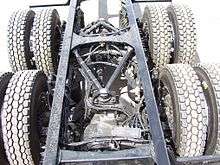
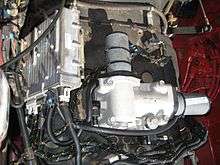
Small trucks use the same type of transmissions as almost all cars, having either an automatic transmission or a manual transmission with synchromesh (synchronizers). Bigger trucks often use manual transmissions without synchronizers, saving bulk and weight, although synchromesh transmissions are used in larger trucks as well. Transmissions without synchronizers, known as "crash boxes", require double-clutching for each shift, (which can lead to repetitive motion injuries), or a technique known colloquially as "floating", a method of changing gears which don't use the clutch, except for starts and stops, due to the physical effort of double-clutching, especially with non-power-assisted clutches, faster shifts, and less clutch wear.
Double-clutching allows the driver to control the engine and transmission revolutions to synchronize so that a smooth shift can be made; for example, when upshifting, the accelerator pedal is released and the clutch pedal is depressed while the gear lever is moved into neutral, the clutch pedal is then released and quickly pushed down again while the gear lever is moved to the next higher gear. Finally, the clutch pedal is released and the accelerator pedal pushed down to obtain the required engine speed. Although this is a relatively fast movement, perhaps a second or so while the transmission is in neutral, it allows the engine speed to drop and synchronize engine and transmission revolutions relative to the road speed. Downshifting is performed in a similar fashion, except the engine speed is now required to increase (while the transmission is in neutral) just the right amount in order to achieve the synchronization for a smooth, non-collision gear change. "Skip changing" is also widely used; in principle, the operation is the same as double-clutching, but it requires neutral be held slightly longer than a single-gear change.
Common North American setups include 9, 10, 13, 15, and 18 speeds. Automatic and automated manual transmissions for heavy trucks are becoming more and more common, due to advances both in transmission and engine power. In Europe, 8, 10, 12, and 16 gears are common on larger trucks with a manual transmission, while conventional automatic or automated manual transmissions would have anything from 5 to 12 gears. Almost all heavy truck transmissions are of the "range and split" (double H shift pattern) type, where range change and so‑called half gears or splits are air operated and always preselected before the main gear selection.
Frame
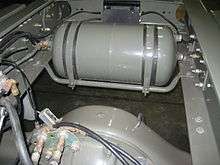
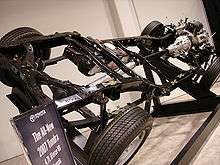
A truck frame consists of two parallel boxed (tubular) or C‑shaped rails, or beams, held together by crossmembers. These frames are referred to as ladder frames due to their resemblance to a ladder if tipped on end. The rails consist of a tall vertical section (two if boxed) and two shorter horizontal flanges. The height of the vertical section provides opposition to vertical flex when weight is applied to the top of the frame (beam resistance). Though typically flat the whole length on heavy-duty trucks, the rails may sometimes be tapered or arched for clearance around the engine or over the axles. The holes in rails are used either for mounting vehicle components and running wires and hoses or measuring and adjusting the orientation of the rails at the factory or repair shop.
The frame is usually made of steel, but can be made (whole or in part) of aluminum for a lighter weight. A tow bar may be found attached at one or both ends, but heavy tractors almost always make use of a fifth wheel hitch.
Body types
Refrigerator trucks have insulated panels as walls and a roof and floor, used for transporting fresh and frozen cargo such as ice cream, food, vegetables, and prescription drugs. They are mostly equipped with double-wing rear doors, but a side door is sometimes fitted.
Box trucks ("tilts" in the UK) have walls and a roof, making an enclosed load space. The rear has doors for unloading; a side door is sometimes fitted.[44]
Concrete mixers have a rotating drum on an inclined axis, rotating in one direction to mix, and in the other to discharge the concrete down chutes. Because of the weight and power requirements of the drum body and rough construction sites, mixers have to be very heavy duty.[45][46]
Dump trucks ("tippers" in the UK) transport loose material such as sand, gravel, or dirt for construction. A typical dump truck has an open-box bed, which is hinged at the rear and lifts at the front, allowing the material in the bed to be unloaded ("dumped") on the ground behind the truck.[47][48]
Flatbed trucks have an entirely flat, level platform body. This allows for quick and easy loading but has no protection for the load. Hanging or removable sides are sometimes fitted.[49]
Semi-tractors ("artics" in the UK) have a fifth wheel for towing a semi-trailer instead of a body.
Tank trucks ("tankers" in the UK) are designed to carry liquids or gases. They usually have a cylindrical tank lying horizontally on the chassis. Many variants exist due to the wide variety of liquids and gases that can be transported.[50]
Wreckers ("recovery lorries" in the UK) are used to recover and/or tow disabled vehicles. They are normally equipped with a boom with a cable; wheel/chassis lifts are becoming common on newer trucks.[51][52][53]
Sales and sales issues
Manufacturers
Truck market worldwide
| Pos. | Make | Units |
|---|---|---|
| 1 | Daimler AG (Mercedes-Benz, Freightliner, Unimog, Western Star, Fuso, BharatBenz) | 506,663[54] |
| 2 | Navistar International | 359,000[55] |
| 3 | Dongfeng | 336,869[56] |
| 4 | Tata | 317,780[57] |
| 5 | Volvo Group (Volvo, Mack, Renault, UD Nissan) | 207,475[58] |
| 6 | Volkswagen Group (MAN, Scania, Caminhões e Ônibus) | 179,035[59] |
| 7 | Hino | 162,870[60] |
| 8 | Paccar (DAF, Kenworth, Peterbilt, Leyland) | 154,700[61] |
| 9 | Iveco | 140,200[62] |
Driving
In many countries, driving a truck requires a special driving license. The requirements and limitations vary with each different jurisdiction.
Australia
In Australia, a truck driver's license is required for any motor vehicle with a Gross Vehicle Mass (GVM) exceeding 4.5 t (4.4 long tons; 5.0 short tons). The motor vehicles classes are further expanded as:
- Combination
- HC: Heavy Combination, a typical prime mover plus semi-trailer combination.
- MC: Multi Combination, e.g., B Doubles/road trains
- Rigid
- LR: Light rigid: a rigid vehicle with a GVM of more than 4.5 t (4.4 long tons; 5.0 short tons) but not more than 8 t (7.9 long tons; 8.8 short tons). Any towed trailer must not weigh more than 9 t (8.9 long tons; 9.9 short tons) GVM.
- MR: Medium rigid: a rigid vehicle with 2 axles and a GVM of more than 8 t (7.9 long tons; 8.8 short tons). Any towed trailer must not weigh more than 9 t (8.9 long tons; 9.9 short tons) GVM. Also includes vehicles in class LR.
- HR: Heavy Rigid: a rigid vehicle with three or more axles and a GVM of more than 8 t (7.9 long tons; 8.8 short tons). Any towed trailer must not weigh more than 9 t (8.9 long tons; 9.9 short tons) GVM. Also includes articulated buses and vehicles in class MR.
- Heavy vehicle transmission
There is also a heavy vehicle transmission condition for a license class HC, HR, or MC test passed in a vehicle fitted with an automatic or synchromesh transmission; a driver's license will be restricted to vehicles of that class fitted with a synchromesh or automatic transmission. To have the condition removed, a person needs to pass a practical driving test in a vehicle with the non-synchromesh transmission (constant mesh or crash box).[63]
Europe
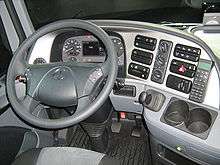
Driving licensing has been harmonized throughout the European Union and the EEA (and practically all European non-member states), so that common rules apply within Europe (see European driving licence). As an overview, to drive a vehicle weighing more than 7.5 t (7.4 long tons; 8.3 short tons) for commercial purposes requires a specialist license (the type varies depending on the use of the vehicle and number of seats). For licenses first acquired after 1997, that weight was reduced to 3.5 t (3.4 long tons; 3.9 short tons), not including trailers.
Since 2013, the C1 license allows driving HGV between 3.5 and 7.5 tonnes, while the C license allows driving Large goods vehicles with a maximum authorized mass of more than 3.5 tonnes.
India
There are around 5 million truck drivers in India.[64]
South Africa
To drive any vehicle with a GVM exceeding 3.5 t (3.4 long tons; 3.9 short tons), a code C1 drivers license is required. Furthermore, if the vehicle exceeds 16 t (15.7 long tons; 17.6 short tons) a code C license becomes necessary.
To drive any vehicle in South Africa towing a trailer with a GVM more than 7.5 t (7.4 long tons; 8.3 short tons), further restrictions apply and the driver must possess a license suitable for the GVM of the total combination as well as an articulated endorsement. This is indicated with the letter "E" prefixing the license code.
In addition, any vehicle designed to carry goods or passengers may only be driven by a driver possessing a Public Driver's Permit, (or PrDP) of the applicable type. This is an additional license that is added to the DL card of the operator and subject to annual renewal unlike the five-year renewal period of a normal license.
The requirements for obtaining the different classes are below.
- "G": Required for the transport of general goods, requires a criminal record check and a fee on issuing and renewal.
- "P": Required for the transport of paying passengers, requires a more stringent criminal record check on, additionally the driver must be over the age of 21 at time of issue. A G class PrDP will be issued at the same time.
- "D": Required for the transport of dangerous materials, requires all of the same checks as class P., In addition, the driver must be over 25 at time of issue.
United States
In the United States, a commercial driver's license is required to drive any type of commercial vehicle weighing 26,001 lb (11,794 kg) or more.[65] The federal government regulates how many hours a driver may be on the clock, how much rest and sleep time is required (e.g., 11 hours driving/14 hours on-duty followed by 10 hours off, with a maximum of 70 hours/8 days or 60 hours/7 days, 34 hours restart )[66] Violations are often subject to significant penalties. Instruments to track each driver's hours must sometimes be fitted. In 2006, the US trucking industry employed 1.8 million drivers of heavy trucks.[67]
There is a shortage of willing trained long distance truck drivers.[68] Part of the reason for this is the economic fallout from deregulation of the trucking industry. Michael H. Belzer, associate professor, in the economics department at Wayne State University and co-author of Sweatshops on Wheels: Winners and Losers in Trucking Deregulation, argues that low pay, bad working conditions and unsafe conditions have been a direct result of deregulation. [69] (Oxford University Press, 2000).[70] The book cites poor working conditions and an unfair pay system as responsible for high annual employee turnover in the industry.[71][72]
Professor Belzer states low pay, bad working conditions, and unsafe conditions have been a direct result of deregulation. "[This book] argues that trucking embodies the dark side of the new economy."[71] "Conditions are so poor and the pay system so unfair that long-haul companies compete with the fast-food industry for workers. Most long-haul carriers experience 100% annual driver turnover.[72][upper-alpha 1]
Environmental impact
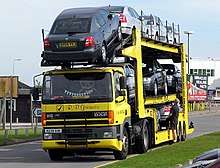
Trucks contribute to air, noise, and water pollution similarly to automobiles. Trucks may emit lower air pollution emissions than cars per equivalent vehicle mass, although the absolute level per vehicle distance traveled is higher, and diesel exhaust is especially dangerous for health.[73] EPA measures pollution from trucks.[74] With respect to noise pollution, trucks emit considerably higher sound levels at all speeds compared to typical cars; this contrast is particularly strong with heavy-duty trucks.[75] There are several aspects of truck operations that contribute to the overall sound that is emitted. Continuous sounds are those from tires rolling on the roadway and the constant hum of their diesel engines at highway speeds. Less frequent noises, but perhaps more noticeable, are things like the repeated sharp-pitched whistle of a turbocharger on acceleration, or the abrupt blare of an exhaust brake retarder when traversing a downgrade. There has been noise regulation put in place to help control where and when the use of engine braking retarders are allowed.
Concerns have been raised about the effect of trucking on the environment, particularly as part of the debate on global warming, so many countries are lowering limits on truck CO2 emissions.[76]
According to a 1995 U.S. government estimate, the energy cost of carrying one ton of freight a distance of one kilometer averages 337 kJ for water, 221 kJ for rail, 2,000 kJ for trucks, and nearly 13,000 kJ for air transport.[77] Many environmental organizations favor laws and incentives to encourage the switch from road to rail, especially in Europe.[78]
The European Parliament is moving to ensure that charges on heavy-goods vehicles should be based in part on the air and noise pollution they produce and the congestion they cause, according to legislation approved by the Transport Committee.[79] The Eurovignette scheme has been proposed, whereby new charges would be potentially levied against things such as noise and air pollution and also weight related damages from the lorries themselves.[80]
A 60-ton tractor & trailer at 80 km/h needs 168 kW : 41% (68 kW) to overcome the rolling resistance, 38% (64 kW) for the aerodynamic drag, 9% (15 kW) for the auxiliaries, 7% (12 kW) for the driveline & tire and 6% (10 kW) is lost in uphill/downhill hysteresis.[81]
Operator health and safety

A truck cab is a hazard control that protects the truck operator from hazardous airborne pollutants. As an enclosure, it is an example of an engineering control. Enclosed operator cabs have been used on agriculture, mining, and construction vehicles for several decades. Most modern-day enclosed cabs have heating, ventilation, and air conditioning (HVAC) systems for primarily maintaining a comfortable temperature and providing breathable air for their occupants. Various levels of filtration can be incorporated into the HVAC system to remove airborne pollutants such as dusts, diesel particulate matter (DPM), and other aerosols.[82]
Two key elements of an effective environmental enclosure are a good filtration system and an enclosure with good integrity (sealed isolation from the outside environment). It is recommended that a filtration system filter out at least 95% or greater of airborne respirable aerosols from the intake airflow, with an additional recirculation filtering component for the inside air. Good enclosure integrity is also needed to achieve positive pressure to prevent wind-driven aerosol penetration into the enclosure, as well as to minimize air leakage around the filtration system. Test methods and mathematical modeling of environmental enclosures are also beneficial for quantifying and optimizing filtration system designs, as well as maintaining optimum protection factor performance for enclosure occupants.[82]
Operations issues
Taxes
Commercial trucks in the US pay higher road use taxes on a state level than other road vehicles and are subject to extensive regulation.[83] A few reasons commercial trucks pay higher road use taxes: they are bigger and heavier than most other vehicles, and cause more wear and tear per hour on roadways; and trucks and their drivers are on the road for more hours per day. Rules on use taxes differ among jurisdictions.
Damage to pavement
The life of a pavement is measured by the number of passes of a vehicle axle. It may be evaluated using the Load Equivalency Factor,[84] which states that the damage by the pass of a vehicle axle is proportional to the 4th power of the weight, so a ten-ton axle consumes 10,000 times the life of the pavement as a one-ton axle. For that reason, loaded trucks cost the same as thousands of cars in pavement costs, and are subject to higher taxes and highway tolls.[34][35]
Commercial insurance
Primary liability insurance coverage protects the truck from damage or injuries to other people as a result of a truck accident. This truck insurance coverage is mandated by U.S. state and federal agencies, and proof of coverage is required to be sent to them. Interstate trucks in the U.S. are required to have a minimum of $75,000 in liability insurance. This includes motor carriers operating vehicles with a gross weight rating in excess of 10,000 lb (4.5 t) (which transport non-hazardous materials). All motor carriers operating vehicles transporting materials classified as hazardous, and which have a gross weight rating in excess of 10,000 lb (4.5 t) must have a minimum of $1,000,000 in liability insurance. All motor carriers operating vehicles such as hopper-type cargo vehicles or tankers with a capacity in excess of 3,500 US gal (13,000 l) must have a minimum of $5,000,000 in liability insurance. Pricing is dependent on region, driving records, and history of the trucking operation.
Motor truck cargo insurance protects the transporter for his responsibility in the event of damaged or lost freight. The policy is purchased with a maximum load limit per vehicle. Cargo insurance coverage limits can range from $10,000 to $100,000 or more. Pricing for this insurance is mainly dependent on the type of cargo being hauled.
Safety
Trucking accidents
In 2002 and 2004, there were over 5,000 fatalities related to trucking accidents in the United States. The trucking industry has since made significant efforts in increasing safety regulations. In 2008, the industry had successfully lowered the fatality rate to just over 4,000 deaths, but trucking accidents are still an issue that causes thousands of deaths and injuries each year. Approximately 6,000 trucking accident fatalities occur annually in the United States. Fatalities are not the only issue caused by trucking accidents. Here are some of the environmental issues that arise with trucking accidents:
- 14.4% of trucking accidents cause cargo to spill
- 6.5% cause open flames
Following increased pressure from The Times "Cities Fit For Cycling" campaign and from other media in Spring 2012, warning signs are now displayed on the backs of many HGVs. These signs are directed against a common type of accident that occurs when the large vehicle turns left at a junction: a cyclist trying to pass on the nearside can be crushed against the HGV's wheels, especially if the driver cannot see the cyclist. The signs, such as the winning design of the InTANDEM road safety competition launched in March 2012, advocate extra care when passing a large vehicle on the nearside.
HGV safety in the EU
In-vehicle speed limitation is required applying a 90 km/h limit to commercial vehicles over 3.5 tonnes.[85]
Front, side, and rear underrun protection is required on commercial vehicles over 3.5 tonnes.[85]
Trucks must be fitted with blind-spot mirrors that give drivers a wider field of vision than conventional mirrors.[86]
See also
- Air brake
- Animal transporter
- Articulated hauler
- Autonomous truck
- Ballast tractor
- Campervan
- Cutaway van chassis
- Dekotora, Japanese decorated trucks
- Food truck
- Glossary of the American trucking industry
- Great West Truck Show
- Hand truck
- Haul truck
- Kei truck
- List of military trucks
- List of pickup trucks
- List of trucks
- Logging truck
- Multi-stop truck
- Roll-off truck
- Tail lift
- Traffic congestion
- Truck art in South Asia
- Truck classification
- Truck hijacking
- Truck scale
- Truck stop
Notes
- As the Atlanta Journal-Constitution wrote: "The cabs of 18-wheelers have become the sweatshops of the new millennium, with some truckers toiling up to 95 hours per week for what amounts to barely more than the minimum wage. [This book] is eye-opening in its appraisal of what the trucking industry has become."[69]
References
- "Glossary" (PDF). www.trucking.org. Archived from the original (PDF) on 29 November 2019. Retrieved 12 September 2019.
- "Truck History". About.com. Retrieved 6 September 2008.
- "Autocar, Always up, Our History". Autocar, LLC. Retrieved 21 October 2018.
- "Debut of diesel engines in tractors and trucks". Daimler AG. Retrieved 27 September 2018.
- Davies, Peter J. (2000). The World Encyclopedia of Trucks. Lorenz Books. pp. 20–21, 114, 118, 160, 204. ISBN 0-7548-0518-2.CS1 maint: ref=harv (link)
- Motor's Truck and Diesel Repair Manual (26 ed.). Motor. 1973. pp. 530, 1035. ISBN 0-910992-16-9.
- "Truck" Merriam-Webster Dictionary
- "Truck" Online Etymology Dictionary 16 September 2010
- "lurry, v." Oxford English Dictionary Online. Oxford University Press. September 2019. Retrieved 1 December 2019.
- "Lorry" Online Etymology Dictionary 16 September 2010
- "Lorry" Merriam-Webster Dictionary
- "The First Ute". ABC – Radio Australia. Retrieved 15 June 2012.
- "49CFR571". Archived from the original on 22 September 2008. Retrieved 31 January 2018.
- "お問い合わせ".
- "Chapter 3. HEAVY TRUCKS – Center for Transportation" (PDF) cta.ornl.gov 20 August 2015
- "An ALMA Antenna on the Move". ESO Picture of the Week. Retrieved 16 July 2012.
- "Heavy Vehicle (Mass, Dimension and loading) National Regulation Schedule 1 (NSW)". New South Wales Government. Retrieved 5 August 2016.
- "Heavy Vehicle (Mass, Dimension and loading) National Regulation Schedule 6 (NSW)". New South Wales Government. Retrieved 5 August 2016.
- "Council Directive 96/53/EC laying down for certain road vehicles circulating within the Community the maximum authorized dimensions in national and international traffic and the maximum authorized weights in international traffic". EUR-Lex. Retrieved 5 August 2016.
- "Freight Management and Operations: Bridge Formula Weights". US Department of Transportation. 21 May 2015. Retrieved 26 May 2015.
- Harborn, Mats; Feng, Feng; Xu, Tommy (2013). "Chinese Road Transport Mass and Dimensions Regulations – An Analysis of the Challenges Ahead". road-transport-technology.org. Retrieved 6 August 2016.
- "Asetus ajoneuvojen käytöstä tiellä". Finlex. Retrieved 2 December 2019.
- "Guidelines on Maximum Weights and Dimensions" (PDF). Ireland Road Safety Authority. February 2013. Retrieved 26 June 2014.
- "Trafikförordningen". Riksdagen. Retrieved 3 March 2017.
- {{cite web|url=https://www.gov.uk/government/publications/special-types-enforcement-guide/special-types-enforcement-guide%7Ctitle=Special types enforcement guide
- "Moving goods by road". HM (UK) Revenue & Customs. 5 April 2016. Retrieved 5 August 2016.
- "A Guide to Haulage & Courier Vehicle Types & Weights" (PDF). Returnloads.net. Retrieved 5 August 2016.
- "Federal Size Regulations for Commercial Motor Vehicles". US Department of Transportation. Retrieved 5 August 2016.
- "Compilation of Exixting State Truck Size and Weight Limit Laws". US Department of Transportation. May 2015. Retrieved 7 August 2016.
- Egan, Paul (13 March 2018). "Does your body ache from hitting potholes? 5 reasons Michigan has lousy roads". Detroit Free Press. Retrieved 16 April 2019.
- Anderson, Bill (17 August 2018). "Michigan's Road Spending: How do we stack up?". Southeast Michigan Council of Governments. Retrieved 16 April 2019.
- Haddad, Ken (22 February 2018). "Pothole questions: Why are Ohio's roads better than Michigan's roads? MDOT points to lack of funding compared to Ohio". Archived from the original on 16 April 2019. Retrieved 16 April 2019.
- Oosting, Jonathhan (2 December 2014). "Michigan road funding: Proposal to cut truck weight limits fails in state Senate". MLive. Retrieved 16 April 2018.
- Chatti, K. (February 2009). "Effect of Michigan Multi-Axle Trucks on Pavement Distress" (PDF). Michigan DOT and Michigan State University, Final Report, Executive Summary, Project RC-1504.
- "Pavement Comparative Analysis Technical Report Comprehensive Truck Size and Weight Limits Study" (PDF). U.S. Department of Transportation, Federal Highway Administration. 15 June 2015.
- Egan, Paul (19 April 2019). "Experts weigh in on how much Michigan's heavy trucks damage the state's roads". Detroit Free Press. Retrieved 21 April 2019.
- Egan, Paul (1 March 2019). "Fixing Michigan's crumbling roads: What about the heavy trucks?". Detroit Free Press. Retrieved 21 April 2019.
- Davies (2000), pp. 58–61.
- Bernstein, Adam (29 January 2008). "Viktor Schreckengost; Designed Bicycles, Dinnerware and More". The Washington Post. Retrieved 26 May 2010.
- Operators Handbook-DM, DMM, U Series. Mack Trucks. 1988. pp. 62–64.
- "EU: Heavy-Duty Truck and Bus Engines". DieselNet. November 2016. Retrieved 15 October 2017.
- "Want a Nikola hydrogen-electric truck? You will have to wait". FreightWaves. 17 April 2019.
- Lambert, Fred (11 January 2019). "Tesla Semi receives another order, electric trucks will move goods in Europe".
- Davies (2000), pp. 30–31.
- "Concrete Mixers (company site)". McNeilus. 2016. Retrieved 24 September 2016.
- "Truck Mixers Summary (Sales Brocure)" (PDF). Stetter. 2016. Retrieved 24 September 2016.
- Davies (2000), pp. 34–35.
- "Dump Truck Operator Manual" (PDF). Galion-Godwin Truck Body Co. Retrieved 13 September 2016.
- Davies (2000), pp. 28–29.
- Davies (2000), pp. 32–33.
- Davies (2000), pp. 46–47.
- "HDR 70/85 Wrecker Operations and Maintenance Manual" (PDF). Jerr-Dan. 2010. Retrieved 13 September 2016.
- "Owner's Manual 820 Wrecker/FIIIT" (PDF). Miller Industries. 1997. Retrieved 13 September 2016.
- "Annual Report 2015". Daimler. 2016. Archived from the original on 2 October 2016. Retrieved 25 September 2016.
- "Form 10K Navistar International Corp". US Securities and Exchange Commission. 2016. p. 48. Retrieved 24 September 2016.
- "2015 Annual Report" (PDF). Dongfeng. 2016. p. 10. Archived from the original (PDF) on 27 September 2016. Retrieved 25 September 2016.
- "70th Annual Report 2015-2015" (PDF). Tata. 2016. p. 53. Archived from the original (PDF) on 9 October 2016. Retrieved 24 September 2016.
- "Annual and Sustainability Report 2015" (PDF). Volvo. 2016. p. 91. Archived from the original (PDF) on 10 October 2016. Retrieved 25 September 2016.
- "Annual Report 2015" (PDF). Volkswagen. 2016. p. 98. Archived from the original (PDF) on 9 October 2016. Retrieved 25 September 2016.
- "Financial Reports for the Fiscal Year Ending" (PDF). Hino Motors. 2016. p. 25. Archived from the original (PDF) on 9 October 2016. Retrieved 25 September 2016.
- "2015 Annual Report" (PDF). PACCAR. 2016. p. 28. Retrieved 25 September 2016.
- "2015 Annual Report" (PDF). CNH. 2016. p. 60. Retrieved 23 October 2016.
- "South Australia License class information". Gov't of South Australia. Retrieved 28 July 2016.
- "Indian Truckers Strike to Protest Against Fuel Price Hike". Deutsche Welle. 2 July 2008.
- "Commercial Drivers License". National Highway Traffic Safety Administration. Archived from the original on 17 September 2008. Retrieved 21 May 2008.
- "Hours of Service Rules". US Federal Motor Carrier Safety Administration. 18 December 2014. Retrieved 26 May 2015.
- "Truck Drivers and Drivers/Sales Workers". Occupational Outlook Handbook. Bureau of Labor Statistics, U.S. Department of Labor. 18 December 2007. Retrieved 25 January 2008.
- Morris, Frank (11 February 2019). "Facing A Critical Shortage Of Drivers, The Trucking Industry Is Changing" (Audio). Morning edition. National Public Radio. Retrieved 17 April 2019.
- "Sweatshops on Wheels". Oxford University Press. July 2000. Retrieved 17 March 2012.
- Belzer, Michael H. (24 August 2000). Sweatshops on Wheels: Winners and Losers in Trucking Deregulation (Hardcover). Oxford University Press, USA. p. 272. ISBN 0-19-512886-9. ISBN 978-0-19-512886-4.
- "Sweatshops on Wheels," U.S. News and World Report.
- "Sweatshops on Wheels." The Washington Post
- "Heavy-Duty Truck and Bus Engines". dieselnet.com. Retrieved 6 September 2008.
- Average In-Use Emissions from Heavy-Duty Trucks (PDF), pages 4–5. EPA, 2008
- C. Michael Hogan (1973). "Analysis of highway noise". Springer Science+Business Media. pp. 387–392. doi:10.1007/BF00159677.
- "EU countries agree to 30 percent cut in truck CO2 emissions". Reuters. 20 December 2018.
- "U.S. Domestic Freight Transportation". United States Department of Energy. Archived from the original on 22 September 2008. Retrieved 6 September 2008.
- "How Government policy can realize rail freight's role in reducing carbon emissions". FreightOnRail.org.uk. Archived from the original on 20 August 2008. Retrieved 6 September 2008.
- MEPs push for green tolls Last retrieved 11-02-09
- European Parliament discuss Eurovignette scheme Last retrieved 10-02-09
- Nils-Olof Nylund (2013). "Vehicle energy efficiencies" (PDF). VTT Technical Research Centre of Finland. Archived from the original (PDF) on 18 August 2018. Retrieved 1 October 2017.
- Organiscak, J.; Cecala, A.; Hall, R. (June 2018). "Design, Testing, and Modeling of Environmental Enclosures for Controlling Worker Exposure to Airborne Contaminants". U.S. National Institute for Occupational Safety and Health. Retrieved 9 November 2018.
- "Trucking Industry Operating Taxes State of Georgia". Archived from the original on 1 September 2006. Retrieved 18 August 2006.
- "Road wear from heavy vehicles – an overview". NVF committee Vehicles and Transports. August 2008. Archived from the original (PDF) on 18 August 2016. Retrieved 27 September 2016.
- https://ec.europa.eu/transport/road_safety/specialist/knowledge/vehicle/safety_design_needs/heavy_goods_vehicles_en
- https://ec.europa.eu/transport/road_safety/topics/vehicles/blind_spot_mirrors_mt
External links
| Wikimedia Commons has media related to Truck. |
- Truck (vehicle) at the Encyclopædia Britannica
- Truck at Curlie
- Federal Motor Carrier Safety Administration
- Different sizes and classes of trucks in the UK
- Hutchinson, Rollin W., Jr. (January 1912). "Motor Trucks – The New Freighters: Quicker and More Reliable Service, Cleaner and Less Congested Cities, Concrete Examples of Saving". The World's Work: A History of Our Time. XXIII: 268–187. Retrieved 10 July 2009.
